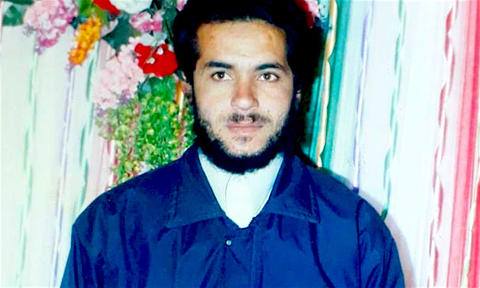Asadullah Haroon Gul, one of the Last Two Afghans in Guantánamo, and a “No-Value Detainee,” Asks to Be Freed

Guantánamo prisoner Asadullah Haroon Gul, known to the U.S. authorities as Haroon al-Afghani, who has been held at the prison without charge or trial since 2007, in a photo taken before his capture.
If you can, please make a donation to support our work in 2020. If you can become a monthly sustainer, that will be particularly appreciated. Tick the box marked, "Make this a monthly donation," and insert the amount you wish to donate.
By Andy Worthington, April 21, 2020
With the prisoners at Guantánamo currently cut off more than ever from the outside world, as the coronavirus threat has brought visits from their attorneys to an end for the foreseeable future, the only way we can hear anything from any of the 40 men still held is if they have written to their attorneys, or if their attorneys have notes from previous meetings with their clients that have been unclassified after being reviewed by the Pentagon’s censorship team.
If any attorneys have any words of their clients that they’d like to share with the world, we’ll be happy to publish them, but in the meantime we’re delighted to cross-post below an article by Asadullah Haroon Gul, one of the last two Afghan prisoners in Guantánamo, and one of the last prisoners to arrive at the prison, in 2007, whose previous missive about Guantánamo — about the threat the coronavirus poses to the men still held — was the subject of our last article, just a few weeks ago.
In this second article, published in Afghanistan Times, Gul specifically focuses on his status as one of the last two Afghan prisoners in Guantánamo (mistakenly describing himself as the last Afghan in the prison, and overlooking Muhammad Rahim, who was the last prisoner to arrive at the prison, in March 2008), and also ties this in with descriptions of some of the other Afghan prisoners held and freed. He also makes a useful distinction, regarding the 40 men still held, between those regarded as “high-value detainees” (HVDs) held in the secretive Camp 7, and the rest — himself included — who he describes as “no value detainees” (NVDs).
Afghan prisoners formerly comprised the largest group in Guantánamo by nationality, with 219 of the 779 men held by the U.S. military throughout the prison’s long history having been Afghans — all now released except for Gul and Rahim. And while it is not quite appropriate to conclude, as he does, that the 217 Afghan prisoners released were all NVDs, it is not far from the truth. None were Al-Qaeda, although a handful held senior positions within the Taliban, although they, of course, should have been held as prisoners of war, under the Geneva Conventions, rather than being held as "enemy combatants" without rights.
The same is true of all the prisoners held, of course, but especially so in the case of the Afghans whose country was invaded. Sadly, U.S. intelligence was so poor that, of the 219 Afghans held, the overwhelming majority were nobodies — random Afghans obliged to fight with the Taliban, the wrong suspects swept up in a variety of largely ill-conceived raids, and, in perhaps dozens of cases, people who were working with the Americans, but had lies told about them by rivals, and who ended up being sent to Guantánamo because the U.S. authorities, with total contempt for justice, had no interest in establishing the truth about those they were holding.
Gul mentions some of these men, the truth of whose stories I helped to expose from 2007, when my book The Guantánamo Files was published, until their eventual release, although he doesn’t mention a particularly outrageous example of this, which involved Abdul Razzaq Hekmati, a lorry driver who had helped a number of prominent anti-Taliban figures escape from a Taliban jail, but who had ended up in Guantánamo because rivals had lied about him. Despite persistently calling for the U.S. authorities to call Afghan officials to find out who he was, Hekmati died of cancer at Guantánamo in December 2007, with the U.S. still maintaining, after his death, the lies they had told about him while he was alive, a situation that I ended up exposing, with Carlotta Gall, in a front-page story for the New York Times in February 2008.
Another sad piece of information in Gul’s article is his revelation that he has "never been visited by an Afghan delegation," a shameful state of affairs, but one that presumably reveals that his own government knew that he was a nobody, but wasn’t even prepared to advocate for his release. I hope Afghan government officials are finally paying attention to Gul’s cries for help from Guantánamo, and I hope you all have time to read his words, and will share them if you find them useful.
I Am A Serial Number
By Guantánamo ISN 3148 (aka Asadullah Haroon), Afghanistan Times, April 5, 2020
The Guantánamo military base is almost invisible to the world; the detainees held here have totally vanished from the world. We are nameless, faceless, referenced by an internment "serial number" – as if we are pieces of hardware, no longer human. A name makes a person individual and unique. Serial numbers are for inanimate objects. I am No. 3148. It is easy to mistreat something called No. 3148. A number does not have dignity.
Importantly, then, I am also Asadullah Haroon, the Afghan citizen from Nangarhar. My wife waits year after year for news that her husband is coming home. My infant baby, Mariam, is now a teenager.
Twenty-three of us "nobody numbers" remain here in Guantánamo. None is Afghan but me, so there is nobody who speaks either Pashto or Dari and I am in danger of losing my language. At least No. 1094, No. 1460 and No. 1461 are Pakistani, and we can speak some Urdu. No. 1460 was so badly tortured, though, that he would rather live in another block essentially alone with his sad thoughts. [Note: No. 1094 is Saifullah Paracha, well-known to "Close Guantánamo" readers, No. 1461 is Ahmad Rabbani, who has also spoken regularly about his imprisonment, and No. 1460 is his brother Abdul Rahim].
Closing out the "no value detainees" (the NVDs) we have No. 27, No. 28, No. 38, No. 63, No. 242, No. 244, No. 309, No. 569, No. 682, No. 685, No. 694, No. 708, No. 841, No. 893, No. 1016, No. 1017, No. 1453, No. 1457, and No. 1463.
At its peak, there were some 760 "no value detainees" at Guantánamo — the largest group were Afghan, some 219 of us NVDs. Thus far, 218 Afghan NVDs have been released, and just one remains — me.
Some will think that because I am still here after 13 years, I must be guilty of some crime — even though I have been held without charges or a trial. But then prejudiced people thought that everyone here was a "terrorist." We are prisoners of a war that has long since ended. And even those who take sides in a war, one in which their country is invaded and the invader kills children with drones, have done nothing wrong. The only way to commit crimes in a war is to do what the U.S. has done, and deliberately kill civilians and torture prisoners of war like me.
As the faceless and numbered men told their stories, the world began to understand what terrible mistakes had been made in sweeping up so many people and bringing them half way around the world to this Cuban prison.
There was No. 1154, Dr. Ali Shah Mousovi, a paediatrician from Gardez, who fled the Taliban and worked for the United Nations. His wife, an economist, and three small children, waited for years before he was released without charge.
There was No. 1009, Haji Nusrat Khan, an 80-year-old from Sarobi, who was brought to Guantánamo on a stretcher. A stroke had left him paralyzed and bedridden. "Look at my white beard. The Americans took me from my home and country with a white beard," he said. "I have done nothing at all. I have not said a word against the Americans." He, like all the rest, was never charged. His old age didn’t safeguard him from "countless humiliations": he was beaten, injured, stripped naked in front of female soldiers. On one occasion, soldiers tied him tightly to a wooden board and left him lying on the ground for some time. One of the soldiers finally glanced down and asked how he was doing. When the interpreter translated. Nusrat began to laugh. "You must be an idiot to ask me this," he said. "I am a paralyzed old man, and you have tied me like a dog on the floor. Look at me. How do you think I am doing?" Soon after his release, Nusrat died in his Sarobi home.
There was No. 1001, Hafizullah Shabaz Khail, a University-educated pharmacist and a staunch supporter of Hamid Karzai’s ascendancy. There was No. 1021, Chaman Gul, who worried incessantly about his aging mother. And No. 560, Afghan Wali Mohammad, who used humour to mask his pain. There was No. 1002, Afghan school teacher Abdul Matin, accused of owning a Casio watch. The list goes on. After years of mistreatment, mental anguish and incalculable indignities, 218 of 219 have been released because they were no threat to anyone, although no doubt some suffer profound depression after their experience.
That means the U.S. has released 99.5% of the Afghan NVD’s. That leaves only me. I am No. 3148, Asad Haroon, and I have watched the others go home. I try to keep busy so I don’t go mad. Sometimes I wonder whether my government has totally forgotten me — I have never been visited by an Afghan delegation. I worry that my countrymen do not care about me. I am nobody — I admit it. I was taken from my home country of Afghanistan all those years ago, flown to this dreadful place, and forgotten. I see the others being released and, while I am happy for them and for their families, it deepens my gloom.
As prisoners are released every day as part of the peace agreement, or to let them go home to help their families during the crisis of this virus, I ask myself the same question every day: Will I ever see my wife and daughter again? Will my respected father and my dear mother still be alive even if I do come home?




